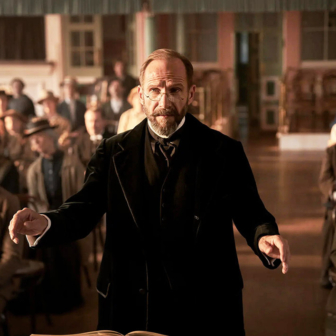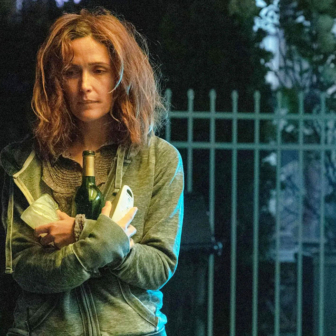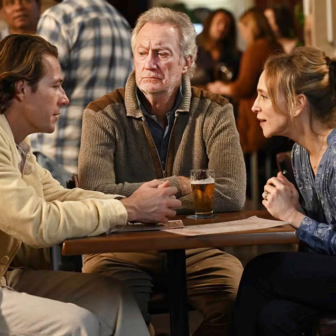Todd Phillips’s 2019 Joker was a phenomenon: a comic-book origin cause célèbre that made more than a billion dollars at the box office, won festival prizes and industry awards and provoked a few anxious media takes about its depiction of violence. It took out the top prize, the Golden Lion, at Venice Film Festival and was nominated in eleven categories, including best film, at the Academy Awards. Joaquin Phoenix, as the title character, won the Oscar for best actor.
Director and star swore that Joker was a one-off, that despite its runaway success there was no risk of the sequel compulsion of so many recent blockbusters. Yet here we are, five years on, with Joker: Folie à Deux, a movie set two years after the events of the first. It finds its title character much as we left him, but more confined, more cadaverous, incarcerated in Arkham asylum and awaiting trial for five murders.
In the first film, Phillips took a character from the DC universe, but rather than pitting him against Batman or teaming him up with other villains, he unashamedly channelled Scorsese’s Taxi Driver (1976) and The King of Comedy (1982) and mixed in elements that recalled some specific, distressing 1980s events: subway killings and child abuse cases, for example, as well as contemporary hot-button issues the film appeared to engage with.
Phoenix’s character, Arthur Fleck, who ends up calling himself “Joker,” is not the deliriously hammy supervillain of Jack Nicholson’s Joker in Batman (1989) or the unnerving psychopath Heath Ledger created for The Dark Knight (2008). Nor does he project the ebullient glee of Cesar Romero in the Sixties Batman TV series. Arthur is a Joker in spite of himself, unmoored, distressed, a fragile individual with a grim childhood and a tenuous grasp on reality. Yet in Phillips’s scenario this would-be comedian who worked as a clown became a killer, a media sensation, a symbol of rebellion, a motif of disaffection, a magnet for social unrest.
This time, in the aftermath of these events, Phillips has chosen to channel other influences and references. Folie à Deux is a kind of jukebox musical with a courtroom drama at its centre and a prelude that’s a faux Looney Tunes cartoon. The most significant new element, however, is Lady Gaga as Harleen “Lee” Quinzel, a figure from the DC universe who is closely associated with Joker.
With little in the way of plot, the film’s central question seems to concern Arthur’s sense of identity: who he is to others and what he is to himself in a “That’s Entertainment” universe of storytelling angles. More than ever, ahead of what has been called the trial of the century, he is a subject of speculation. His well-meaning lawyer (Catherine Keenan) wants to use an insanity defence, to argue that he has developed a split personality as a way of dealing with trauma. The prosecution presents him as a monster. The guards in Arkham mock and degrade him. Admirers — a few inside Arkham, many more outside — still see him as a heroic figure.
Folie à Deux has a running joke about an unnamed “TV movie” of Arthur’s life that has attracted many viewers. It’s as if Phillips is referencing his own film as part of his gleeful cannibalising of movie and musical history. One of the repeat viewers, it turns out, is Gaga’s character, Lee, whom we first meet as a Joker superfan, a wide-eyed inmate at Arkham.
Lee relates to Arthur, she tells him. She’s from his neighbourhood and she’s in the asylum because she burned down her parents’ apartment. In fact, she is not quite what she seems, Arthur will learn, but there is no obvious doubt about her devotion to him and what he represents to her.
The first time the pair exchange glances, Lee makes a familiar gesture: she mimes holding a gun to her temple and pulling the trigger. It mirrors the first glimpse in Joker of Arthur’s then-neighbour Sophie (Zazie Beetz), who did the same thing. Or did she? It’s possible that this moment, a homage to Taxi Driver, existed only in Arthur’s mind: most of his interactions with Sophie were products of his imagination, expressions of his wish to be close to her. In Folie à Deux, Lee’s repetition of the gesture does two things: it connects her to Sophie, that earlier object of desire; and it raises the possibility that she saw a scene like that in the “TV movie” and knows it will mean something to Arthur.
Either way, she is there, a new character in his world, seemingly offering the intimacy he craves. But is what we are seeing a folie à deux — a shared delusion — or something more tender or more manipulative? Or is their complicity little more than a mutual fondness for show tunes and the odd duet?
In the end, the answer is fairly straightforward. Along the way, Phillips explores their relationship in episodic fashion, through song and dance. The Folie à Deux songbook is drawn from pre-existing numbers, ranging from MGM classics to Carpenters hits, from “Get Happy” to “Gonna Build a Mountain” to Arthur singing Jacques Brel’s “If You Go Away” into a payphone. There is a deliberate awkwardness to much of the presentation: Gaga sings at first in character as Lee, then becomes stronger and more emphatic; Phoenix retains a wavering, scratchy quality throughout.
Sometimes there’s a bit of attempted razzle dazzle: a Bee Gees number presented like a performance from Sonny and Cher’s TV variety show, complete with snarky banter, and one vivid, energetic set-piece that conveys a sense of exhilaration that almost feels as if it came from an old-fashioned musical. But the songs function mostly as projections of Arthur’s psyche, soliloquies or reveries that express longings that don’t translate into the world beyond. And as a performer and a presence, Gaga has a lot to offer, but her character is never really developed or given more than fleeting context. It is as if the figure of Lee is inserted into the narrative from time to time to represent different challenges to Arthur’s sense of self.
The musical elements have a certain fascination, but the courtroom material is all over the place, heavy-handed and tiresome, rehashing the events of the first film in ways that flatten rather than illuminate.
It feels all too punishing. By the conclusion of Folie à Deux, Phillips seems to have done all he can with Arthur Fleck. Surely it’s time to let him go. A few possibilities created by the story could, at a pinch, be developed further. But it’s hard to imagine any appetite or reward for this, for Phillips or Phoenix. This time, it definitely feels as if the joke is over. •




